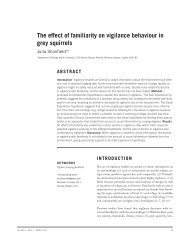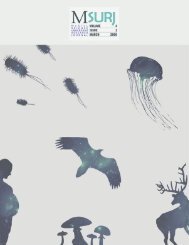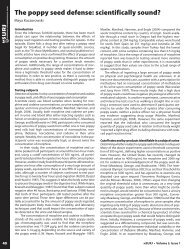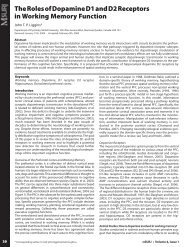the entire issue - McGill Science Undergraduate Research Journal ...
the entire issue - McGill Science Undergraduate Research Journal ...
the entire issue - McGill Science Undergraduate Research Journal ...
Create successful ePaper yourself
Turn your PDF publications into a flip-book with our unique Google optimized e-Paper software.
RESEARCH ARTICLE<br />
Selecting for multicellularity in <strong>the</strong><br />
unicellular alga Chlamydomonas reinhardtii<br />
Tyler Moulton 1 *, Dr. Graham Bell 1<br />
1<br />
Department of Biology, <strong>McGill</strong> University, Montreal, QC<br />
*Email Correspondence:<br />
tyler.moulton@mail.mcgill.ca<br />
Keywords:<br />
Multicellularity: The state defined<br />
by an organism comprised of more<br />
than one cell, often associated with<br />
division of labour among cells.<br />
Volvocaceae: Family of algae representing<br />
a gradient of unicellular to<br />
multicellular species.<br />
Chlamydomonas reinhardtii: A<br />
unicellular, flagellated, volvocacean<br />
alga.<br />
Artificial Selection: Consistent,<br />
biased, guided selection for a phenotypic<br />
trait in a population.<br />
Abstract<br />
Background: <strong>Research</strong>ers have recently begun experimentally exploring <strong>the</strong> origins of multicellularity<br />
(4-6). Their studies have found that <strong>the</strong> transition to a multicellular state may have been surprisingly<br />
simple, considering its profound implications for <strong>the</strong> history of life (3). This study experimentally selected<br />
for multicellularity in <strong>the</strong> unicellular biflagellated alga Chlamydomonas reinhardtii. This organism is<br />
especially interesting because it is basal to <strong>the</strong> Volvocaceae—a family of biflagellates whose evolutionary<br />
transition from unicellular organisms to complex forms have been meticulously characterised (2). The<br />
present study aimed to recreate <strong>the</strong> early stages of this transition, starting from incomplete cytokinesis<br />
after cell division.<br />
Methods: The procedure was modeled loosely on <strong>the</strong> experiment performed by Ratcliff et al. (4) in which<br />
<strong>the</strong> authors successfully selected for multicellular Saccharomyces Cerevisiae—unicellular baker’s yeast. Three<br />
experimental replicates and one control for nine strains of C. reinhardtii were cultured in round-bottom<br />
vials in shaking incubators. Prior to each transfer (every 3-4 days), each culture was slowly mixed, and<br />
selection lines were <strong>the</strong>n gently and briefly centrifuged. This applied a selection pressure which rendered<br />
heavier (clustered) cells more fit. The very bottom ~2% of <strong>the</strong> tubes’ contents was transferred, and cell<br />
cultures were examined for multicellularity.<br />
Results: Six of nine lines of C. reinhardtii demonstrated an increased frequency of C. reinhardtii existing in<br />
a two- to four-celled state (<strong>the</strong> paired cell state accounted for 88% of <strong>the</strong>se clusters)—consistent with <strong>the</strong><br />
first step toward multicellularity as outlined by Kirk (2). A close study of cell division in <strong>the</strong> line which<br />
exhibited <strong>the</strong> strongest shift towards <strong>the</strong> multicellular phenotype suggests that true multicellularity<br />
began to evolve in this experiment. A multicellular phenotype did not become fixed in any population.<br />
Conclusion: Our findings suggest that an artificial selection pressure is capable of inducing <strong>the</strong> evolution<br />
of multicellularity. Expanding upon this study could help us understand <strong>the</strong> mechanisms underlying <strong>the</strong><br />
evolution of multicellularity.<br />
Limitations: Sporadic data, possibly <strong>the</strong> result of difficulties in <strong>the</strong> procedure, prevented us from rigorously<br />
examining <strong>the</strong> effect of selection through time, limiting our ability to describe <strong>the</strong> evolutionary response.<br />
In addition, <strong>the</strong> study of individual cells, due to its time-consuming nature, was limited to one replicate of<br />
one line exhibiting a pronounced multicellular response. Thorough replication would be required before<br />
drawing a strong conclusion from this assay.<br />
Introduction<br />
Multicellularity is one of <strong>the</strong> most crucial innovations in <strong>the</strong> history<br />
of life, allowing for drastic increases in organismal size and complexity.<br />
Multiple phyla and clades within <strong>the</strong>se phyla have independently<br />
evolved this trait (1, 2) suggesting that this innovation may be fairly<br />
easy to achieve (3, 4). Boraas (5) found that in a predator-prey chemostat,<br />
unicellular Chlorella vulgaris evolved a multicellular phenotype<br />
in response to predation from a flagellated protist. Koschwanez et al.<br />
(6) demonstrated that cell clumping greatly increases fitness of Saccharomyces<br />
cerevisiae in dilute sucrose solution due to metabolite<br />
sharing from secreted hydrolytic enzymes. Ratcliff et al. (4)* have<br />
recently reported <strong>the</strong> successful evolution of multicellular yeast simply<br />
by selecting for heavier cells via centrifugation. The yeast even<br />
* The paper by Ratcliff et al. was published after <strong>the</strong> present study was carried out.<br />
Citation: W.C. Ratcliff F. Denison, M Borrello, M. Travisano. Proc. Natl. Acad. Sci U.S.A. 109,1595-1600 (2012)<br />
30<br />
<strong>McGill</strong> <strong>Science</strong> <strong>Undergraduate</strong> <strong>Research</strong> <strong>Journal</strong> - msurj.mcgill.ca









